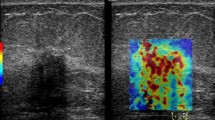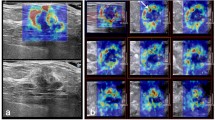Abstract
Objective
To evaluate the correlation between stiffness values obtained by shear-wave elastography (SWE) and breast cancer subtypes.
Methods
This was an institutional review board-approved retrospective study with a waiver of informed consent. The stiffness of 337 invasive breast cancers in 337 women was evaluated by SWE and mean stiffness values (kPa) and qualitative colour scores (1–5) of tumours were obtained. The results were analysed according to BI-RADS category, tumour size, grade and tumour subtype (triple-negative [TN], human epidermal growth factor receptor 2 [HER2]-positive, and oestrogen receptor [ER]-positive) using a multiple linear regression analysis.
Results
The mean stiffness values and colour scores were: 146.8 kPa ± 57.0 and 4.1 ± 1.1; 165.8 kPa ± 48.5 and 4.6 ± 0.7 for TN tumours (n = 64), 160.3 kPa ± 56.2 and 4.3 ± 1.0 for HER2-positive tumours (n = 55) and 136.9 kPa ± 57.2 and 4.0 ± 1.1 for ER-positive tumours (n = 218; P < 0.0001). All three breast cancers classified as BI-RADS category 3 on B-mode ultrasound were TN subtype. A multiple linear regression analysis revealed that tumour size, histological grade and tumour subtype were independent factors that influenced the stiffness values.
Conclusion
High stiffness values correlated with aggressive subtypes of breast cancer.
Key points
• Shear-wave elastography is increasingly used to measure the stiffness of breast tumours.
• Triple-negative and HER2-positive tumours showed greater stiffness than ER-positive tumours.
• All breast cancers classified as BI-RADS 3 on B-mode ultrasound were triple-negative subtype.
• Tumour size, histological grade and subtype were independent factors influencing SWE stiffness.







Similar content being viewed by others
References
Cosgrove DO, Berg WA, Doré CJ et al (2012) Shear wave elastography for breast masses is highly reproducible. Eur Radiol 22:1023–1032
Evans A, Whelehan P, Thomson K et al (2010) Quantitative shear wave ultrasound elastography: initial experience in solid breast masses. Breast Cancer Res 12:R104
Chang JM, Moon WK, Cho N et al (2011) Clinical application of shear wave elastography (SWE) in the diagnosis of benign and malignant breast diseases. Breast Cancer Res Treat 129:89–97
Berg WA, Cosgrove DO, Doré CJ et al (2012) Shear-wave elastography improves the specificity of breast US: the BE1 multinational study of 939 masses. Radiology 262:435–449
Evans A, Whelehan P, Thomson K et al (2012) Invasive breast cancer: relationship between shear-wave elastographic findings and histologic prognostic factors. Radiology 263:673–677
Perou CM, Sørlie T, Eisen MB et al (2000) Molecular portraits of human breast tumours. Nature 406:747–752
Goldhirsch A, Wood WC, Coates AS et al (2011) Strategies for subtypes-dealing with the diversity of breast cancer: highlights of the St. Gallen International Expert Consensus on the Primary Therapy of Early Breast Cancer. Ann Oncol 22:1736–1747
Longo DL (2012) Tumor heterogeneity and personalized medicine. N Engl J Med 366:956–957
Desmedt C, Haibe-Kains B, Wirapati P et al (2008) Biological processes associated with breast cancer clinical outcome depend on the molecular subtypes. Clin Cancer Res 14:5158–5165
Sánchez-Muñoz A, García-Tapiador AM, Martinez-Ortega E et al (2008) Tumour molecular subtyping according to hormone receptors and HER2 status defines different pathological complete response to neoadjuvant chemotherapy in patients with locally advanced breast cancer. Clin Transl Oncol 10:646–653
Nicholson RI, Johnston SR (2005) Endocrine therapy: current benefits and limitations. Breast Cancer Res Treat 93:S3–S10
Tokunaga E, Oki E, Nishida K et al (2006) Trastuzumab and breast cancer: developments and current status. Int J Clin Oncol 11:199–208
Bae MS, Han W, Koo HR et al (2011) Characteristics of breast cancers detected by ultrasound screening in women with negative mammograms. Cancer Sci 102:1862–1867
Uematsu T, Kasami M, Yuen S (2009) Triple-negative breast cancer: correlation between MR imaging and pathologic findings. Radiology 250:638–647
Wang Y, Ikeda DM, Narasimhan B et al (2008) Estrogen receptor–negative invasive breast cancer: imaging features of tumors with and without human epidermal growth factor receptor type 2 overexpression. Radiology 246:367–375
Au-Yong IT, Evans AJ, Taneja S et al (2009) Sonographic correlations with the new molecular classification of invasive breast cancer. Eur Radiol 19:2342–2348
Basu S, Chen W, Tchou J et al (2008) Comparison of triple-negative and estrogen receptor-positive/progesterone receptor-positive/HER2-negative breast carcinoma using quantitative fluorine-18 fluorodeoxyglucose/positron emission tomography imaging parameters: a potentially useful method for disease characterization. Cancer 112:995–1000
Dogan BE, Gonzalez-Angulo AM, Gilcrease M, Dryden MJ, Yang WT (2010) Multimodality imaging of triple receptor-negative tumors with mammography, ultrasound, and MRI. AJR Am J Roentgenol 194:1160–1166
Youk JH, Gweon HM, Son EJ, Kim JA, Jeong J (2013) Shear-wave elastography of invasive breast cancer: correlation between quantitative mean elasticity value and immunohistochemical profile. Breast Cancer Res Treat 138:119–126
Lee SH, Chang JM, Kim WH et al (2012) Differentiation of benign from malignant solid breast masses: comparison of two-dimensional and three-dimensional shear-wave elastography. Eur Radiol 23:1015–1026
Gweon HM, Youk JH, Son EJ, Kim JA (2012) Visually assessed colour overlay features in shear-wave elastography for breast masses: quantification and diagnostic performance. Eur Radiol 23:658–663
Schrading S, Kuhl CK (2008) Mammographic, US, and MR imaging phenotypes of familial breast cancer. Radiology 246:58–70
D’Orsi CJ, Bassett LW, Berg WA et al (2003) Breast Imaging Reporting and Data System, BI-RADS: Mammography, 4th edn. American College of Radiology, Reston
Elston CW, Ellis IO (1991) Pathological prognostic factors in breast cancer. I. The value of histological grade in breast cancer: experience from a large study with long-term follow-up. Histopathology 19:403–410
Hammond ME, Hayes DF, Dowsett M et al (2010) American Society of Clinical Oncology/College Of American Pathologists guideline recommendations for immunohistochemical testing of estrogen and progesterone receptors in breast cancer. J Clin Oncol 28:2784–2795
Mendelson EB, Baum JK, Berg WA, Merritt CRB, Rubin E (2003) Breast Imaging Reporting and Data System, BI-RADS: Ultrasound, 1st edn. American College of Radiology, Reston
Levental KR, Yu H, Kass L et al (2009) Matrix crosslinking forces tumor progression by enhancing integrin signaling. Cell 139:891–906
Butcher DT, Alliston T, Weaver VM (2009) A tense situation: forcing tumour progression. Nat Rev Cancer 9:108–122
Baker EL, Lu J, Yu D, Bonnecaze RT, Zaman MH (2010) Cancer cell stiffness: integrated roles of three-dimensional matrix stiffness and transforming potential. Biophys J 99:2048–2057
Jugé L, Doan BT, Seguin J et al (2012) Colon tumor growth and antivascular treatment in mice: complementary assessment with MR elastography and diffusion-weighted MR imaging. Radiology 264:436–444
Ferraioli G, Tinelli C, Dal Bello B et al (2012) Accuracy of real-time shear wave elastography for assessing liver fibrosis in chronic hepatitis C: a pilot study. Hepatology 56:2125–2133
Magri F, Chytiris S, Capelli V et al (2012) Shear wave elastography in the diagnosis of thyroid nodules: feasibility in the case of coexistent chronic autoimmune Hashimoto’s thyroiditis. Clin Endocrinol (Oxf) 76:137–141
Tamaki K, Ishida T, Miyashita M et al (2011) Correlation between mammographic findings and corresponding histopathology: potential predictors for biological characteristics of breast diseases. Cancer Sci 102:2179–2185
Lamb PM, Perry NM, Vinnicombe SJ, Wells CA (2000) Correlation between ultrasound characteristics, mammographic findings and histological grade in patients with invasive ductal carcinoma of the breast. Clin Radiol 55:40–44
Samani A, Bishop J, Luginbuhl C, Plewes DB (2003) Measuring the elastic modulus of ex vivo small tissue samples. Phys Med Biol 48:2183–2198
Acknowledgments
The research was supported by the Converging Research Center Program through the Ministry of Education, Science and Technology (2012K001499), the National Research Foundation of Korea (NRF) grant funded by the Korean government (MEST) (no. 2012A01010846), and the SNUH Research Fund (03-2012-0400).
The SWE data of 61 of 337 of our subjects have been used and published in our previous paper [3].
Author information
Authors and Affiliations
Corresponding author
Rights and permissions
About this article
Cite this article
Chang, J.M., Park, I.A., Lee, S.H. et al. Stiffness of tumours measured by shear-wave elastography correlated with subtypes of breast cancer. Eur Radiol 23, 2450–2458 (2013). https://doi.org/10.1007/s00330-013-2866-2
Received:
Revised:
Accepted:
Published:
Issue Date:
DOI: https://doi.org/10.1007/s00330-013-2866-2




